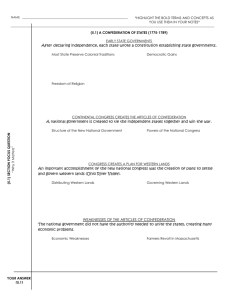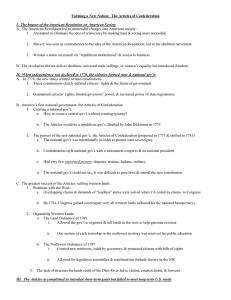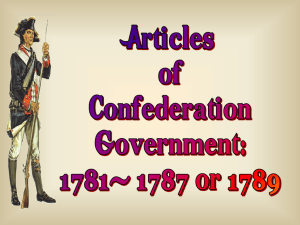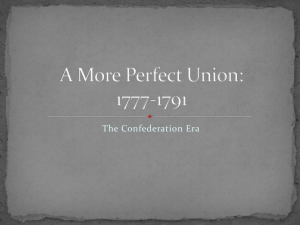The Americans
advertisement
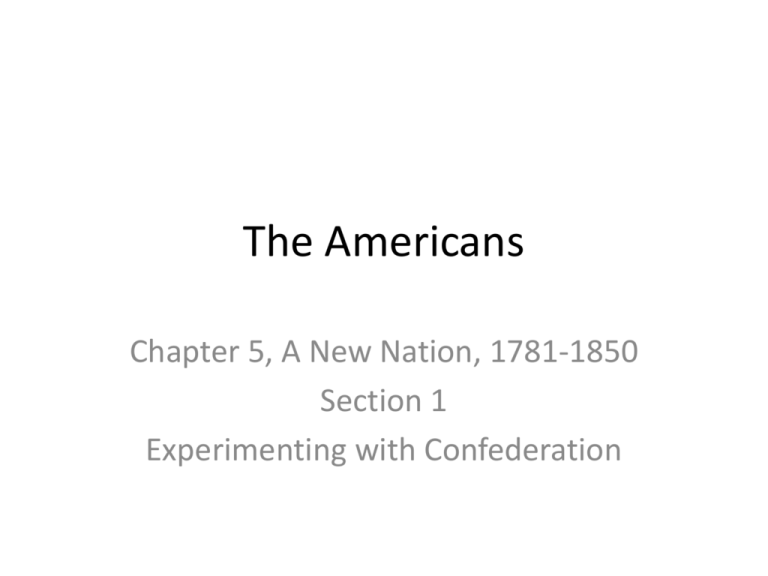
The Americans Chapter 5, A New Nation, 1781-1850 Section 1 Experimenting with Confederation Americans Debate Republicanism • Creating a new government was hard • Each colony (state) is different and had different rules • How can the new states connect with the new government and work together as one? Colonies become States • Each colony had its own governor (leader), council, and colonial assembly • People thought each colony has its own government or a “primary political unit” • Most people were loyal to their colony rather than the country, except during the Revolutionary War, when they all worked together Colonies become States • Colonies became states • Colonies were nervous about giving up their “state government” to a strong central government • A system of government had to be formed that was fair for all of the different interests of the states Unity through a Republic • All of the people were not educated enough to run a country • Republic – citizens elect representatives for government • Republicanism – governments should be based on the consent or approval of the people • Value on the nation vs Value on personal interests? State Constitutions • Each state created their own constitutions, but shared their desire for freedom of speech, religion and press, but didn’t want a “centralized authority” or one leader making decisions • States disagreed on who can vote (all white males, property owners, etc.) Political Precedents • Most nations were ruled by kinds, so the new country had little models to refer to • Leaders researched history of governments but had difficulty • The US was different because the government had to balance the concerns of both the state and nation The Continental Congress Debates • States developed individual constitutions • Continental Congress tried to create one for all of the states • There was much disagreement. The Congress has to answer 3 questions: – Representations by population or by state? – Supreme Power: Can it be divided? – Western Lands: Who gets them? Representation by Population or by State? • States were equal in political power, but different in size, wealth, & population • Is it fair for the states to have more representatives in Congress because their state and population is larger? • Continental Congress decided each state would have one vote, no matter how large or small the population is Supreme Power: Can It be Divided? • Most thought a central government couldn’t share power with the individual states • Articles of Confederation: 2 levels of government shared the power (State and National) – National: declare war, make peace, sign treaties, borrow money, create currency (money) standards, create a postal service, deal with Native Americans • This new government was called confederation, meaning alliance (join together as a team) Western Lands: Who Gets Them? • 12 of the 13 states agreed to the new government • Some states claimed land west of the Appalachian Mountains • Smaller states, like Maryland, worried that larger states would take over • Maryland refused to agree to the new government until states gave up Western lands • States gave up western lands and Maryland signed the Articles of Confederation in March 1781. Governing the Western Lands • Land Ordinance of 1785 – survey or examine the land • Northwest Ordinance of 1787 – divided the lands into territories, and adding new states – This ordinance ignored the Native American’s claim to land – Conferation’s greatest achievement because it created future growth of the nation Political & Economic Problems • Most serious problem: country lacked unity • Each state worried about itself only instead of the country • Changes in government was difficult, because each state had to vote and agree • Congress owed money from the Revolutionary War to foreign countries • Congress wanted to tax foreign goods to raise money, but one state said no Borrowers vs. Lenders • Creditors (Lenders of Money) let people borrow money • Debtors (borrowers of Money) people who owed money and had to pay it back • Creditors wanted a high tax added to borrowed money, but debtors couldn’t afford the high tax and couldn’t pay them back • Creditors sued the debtors, and the government would take the debtor’s land Borrowers vs. Lenders continued
